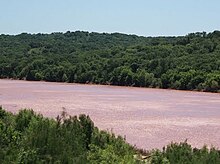Snagboat
This article includes a list of general references, but it lacks sufficient corresponding inline citations. (January 2012) |

A snagboat is a river boat, resembling a
USA

During the American Civil War, when much of the naval fighting was done on rivers and their tributaries, numerous snagboats were in operation. USS Benton, for example, was a commercial snagboat quickly converted by the Union Army to a river gunboat when the American Civil War broke out.
Snagboats of the USA
W. T. Preston is a specialized sternwheeler that operated as a snagboat, removing log jams and natural debris that prevented river navigation on several Puget Sound-area rivers. She is now the centerpiece of the Snagboat Heritage Center in Anacortes, Washington. She was designated a National Historic Landmark in 1989.[1]
Yuba was a stern-wheeled, shallow draft steamship ordered by the United States Army Corps of Engineers) to serve as a snagboat on the Sacramento River after the Seizer (240 GRT, 1881), had retired in 1921[2]
Great Raft

In the early 19th century, settlers found that much of the Red river's length in Louisiana was unnavigable because of a collection of fallen trees that formed a Great Raft over 160 miles (260 km) long. In 1839, Captain Henry Miller Shreve began clearing the log jam, but it was not completely cleared until the 1870s, when dynamite became available. The river was thereafter navigable, but north of Natchitoches it was restricted to small craft. Removal of the raft further connected the Red and Atchafalaya rivers, accelerating the development of the Atchafalaya River channel.[3]
Canada
In Canada, many of the rivers of
The snag-clearance service was mainly important on the Fraser River because of the large amount of marine traffic. Passenger and freight-carrying sternwheelers operated out of
Gallery
-
The snagboat Bear which operated on the Sacramento River (1920s)
-
The snagboat Mandan seen from a bluff overlooking the Missouri River (July 1912).
-
The snagboat W. T. Preston (retired)
See also
- Montgomery
- WT Preston
- Yuba
References
- ^ "W.T. PRESTON (Snagboat)". National Historic Landmarks Program. National Park Service. Retrieved 2008-06-26.
- ^ "Sacramento River: Snag-Boat: "Seizer"". History & Happenings. December 12, 2012.
- ISBN 978-1-62349-039-3.
- Sheret, Robin E, "Smoke, Ash and Steam: West Coast Steam Engines". Western Isles, Victoria, B.C. 1997,
- Stroh, Scott. "The Snagboat W. T. Preston: A Case Study in the Dry Berth Preservation of Historic Vessels". San Francisco Maritime National Historical Park Association.
- "Snagboat E. A. Woodruff". Ohio County Public Library. Archived from the original on June 5, 2011.
{{cite web}}: CS1 maint: unfit URL (link) - "U.S. Snagboat Montgomery Pickensville, Alabama". The History Workshop. Archived from the original on 2008-07-23.
- Martin, Mark E., ed. (2006). "Army Corp of Engineers river snagboat C. R. Suter photographs, ca. 1885" (PDF). Louisiana State University Libraries (Archive inventory). Louisiana State University.



